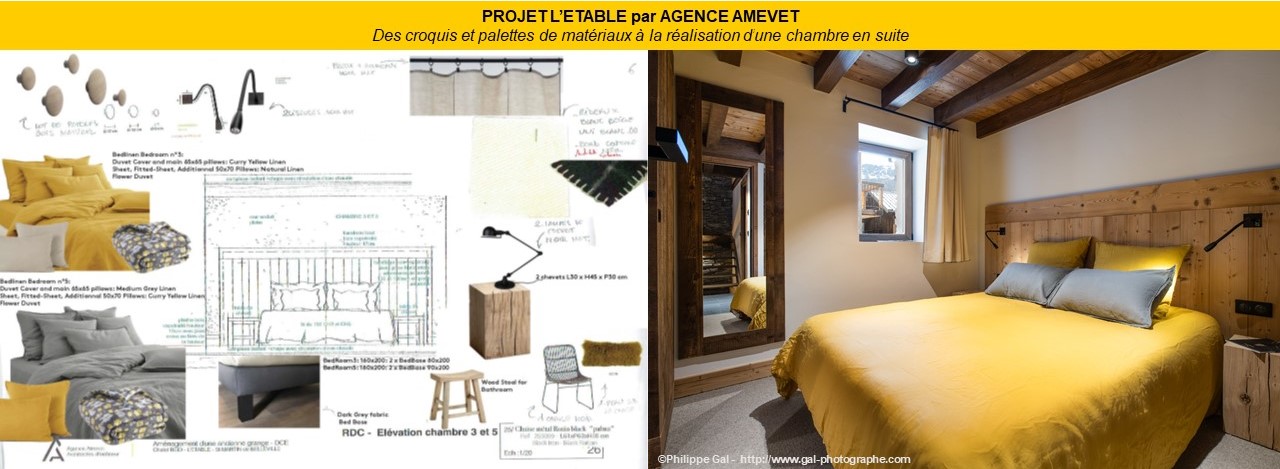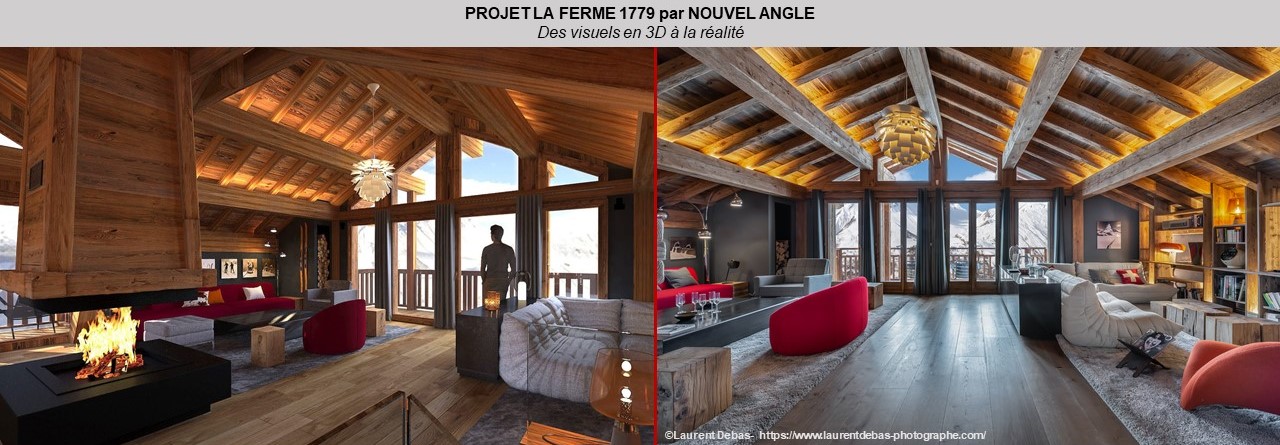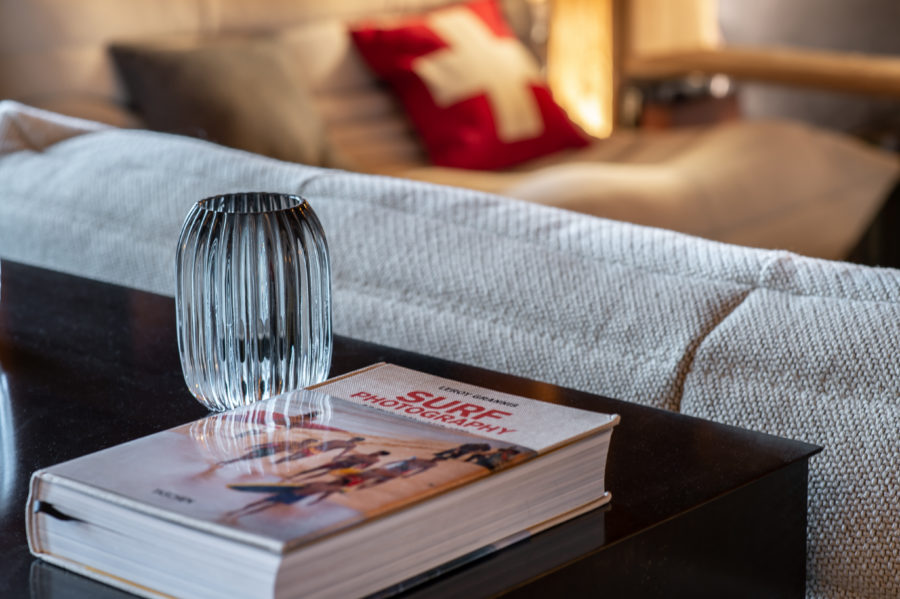Decor & interior design materials trends
Five questions posed to Pierre François Amevet, Director of the Amevet Agency and Bastien Jovelet, Director of Nouvel Angle, PROMOJAY’s partnering interior designers.
Could you briefly introduce yourself?
P.F Amevet: Our interior design agency with eleven employees is based in Chambéry, Savoy and it comprises six architects, a coordinator, an assembler, a marketing and communications manager, an administrative manager and a graphic designer. We foster team spirit and service-mindedness towards our customers, private individuals and professionals for whom we work on new and renovation projects. Our location in the heart of the Alps has naturally led to our gaining of expertise in the domain of chalets and mountain dwellings.
B. Jovelet: After spending almost 20 years designing TV sets for shows such as The Voice, Masterchef and Star Academy, the opportunity arose to become involved in the design of ambitious architectural projects such as Sky2.0, a huge outdoor nightclub in Dubai. This turning point and a desire for pushing boundaries led me to establish my own interior design agency in 2017, Nouvel Angle.
I work with my team of interior designers and decorators to conceptualise the renovation of apartments and houses in the Paris region, restaurants and shops in Lyon and elsewhere, and, of course, chalets in Savoy. We rethink spaces as well as decorate them, which allows us to offer a turnkey service, including the fitting of all furniture and accessories.
What are the current trends in terms of décor and interior design for mountain chalets and apartments?
P.F. Amevet: The main trend is the use of classic materials such as wood, stone, glass and metal, but given a fresh spin. For example, wooden cupboard doors can be paired with a metal frame and leather interior. The railings are minimalist, in lacquered metal with a transparent glass inner… The aim is also to maximise available light and retain it, for example using light-reflecting wall plaster treatments.
In terms of amenities, chalets are increasingly being equipped with creature comforts such as saunas, steam rooms, ski rooms and gyms. The bathrooms are en-suite. The equipment is controlled remotely: the sauna or steam room can be switched on from the slopes, or the chalet can be preheated from abroad. Everything that adds to the level of comfort and enhances use is drawn on!
B. Jovelet: Chalet décor has changed significantly over the past few years, classic has made way for designer, all the leading interior design agencies have developed new styles marking a break from what was being done before. They have also created a somewhat cool, mineral style devoid of colour and with clean lines.
With most of the chalets intended to be rented out, they may be kept as neutral as possible to appeal to a wide range of different tastes?
That’s not my own personal design philosophy, I believe a home or chalet be warm. Light, materials and colours must be handled accordingly. I don’t believe that the answer is to remain neutral, on the contrary, what I offer is a unique, customised spaces owners can be proud of.
To achieve this, the study of light is key, it must be soft, warm and set off the artisans’ work – especially the framework. I like to incorporate designer lighting from the 60s and 70s, which I combine with more modern lighting and LEDs. Furniture choice is also important, and here I also mix different styles and eras, aiming to find a balance in each area of the room. I prefer each area of the chalet to be different, but forming a unified whole.
What is your source of inspiration?
P.F Amevet: It bears mentioning that our customers’ specifications are becoming increasingly comprehensive, describing very specific expectations in terms of both feel and fittings. To ensure their expectations are met, we do a lot of internet research, research in specialist publications, and supplier catalogues and showrooms. We attend trade shows to ensure we follow the latest trends in terms of materials (wood, stone, tiles, flooring, etc.) and fittings (bathrooms, wellness areas, lighting, home automation, etc.).
B. Jovelet: I try not to draw inspiration from other chalets, but rather from what is being done across the world. Whether inspired by a home in Brazil, an apartment in Paris or a restaurant in Istanbul, there are always décor or interior design ideas that can be inspiring for a chalet. With today’s means of communication, everything is within reach. Photos of the most scenic places in the world are listed on Pinterest, the major décor magazines publish on Instagram – everything is just a click away and can be shared.
I love restaurant décor which is a great source of inspiration for me. Designers are given greater freedom of reign there than in homes, eliciting unusual, novel ideas. The overall atmosphere, feel is focused on, that’s what I try to subsequently reproduce in the chalets. Their lighting treatment is also very important.
Finally, trade shows such as Maison & Objet provide the opportunity to meet all furniture manufacturers and importers. They all attend, which means one can forge new contacts and expand the range of furniture offered to customers. From 60s to Scandinavian design, ethnic Bohemia to an arty style, there’s something to be found to suit all tastes and pockets.
What are your favourite materials?
P.F. Amevet: We love beautiful materials, noble materials such as wood, stone, metal and glass. For curtains and other coverings, we favour the use of natural materials such as linen and wool. Old wood is always a timeless winner which can be fitted with different finishes and in different hues to give a specific feel to the project.
B. Jovelet: I pair traditional materials such as larch, flagstone and slate – with diametrically opposed materials such as Corian, steel and glass – to strike a balance between tradition and modernity. Similarly, I like to cover a very modern couch with an Alpine wool, or set off a matte black metal bookcase against an old wood background.
For the Ferme de 1779, the kitchen island is a huge matte white slab in Corian, while its resting support is made from old salvaged wood. The chimney of Apartment 3 of L’Epicerie is inspired by the most modern, clean lines, featuring wood and metal cladding.
For all things traditional, their materials and know-how, I particularly like Arpin, a Savoyard spinning mill that exclusively weaves Alpine wool. They sell magnificent throws, cushions, tartans and curtains.
For modernity, Tom Dixon has created beautiful light fittings with a dazzling play on reflections and transparencies.
I also love to work with bespoke artisans, and particularly with Unobium for tables. This allows you not only to get the perfect fit, but also to choose the style, wood grain, hue and feet for the crafting of a very unique table.
What are the key principles you advocate?
P.F. Amevet: A love for work well done and team spirit, shared with our customers and artisan partners.
B. Jovelet: It’s clear that my work is based on contrasts.
What perception does one have of a chalet? The contrast between the warmth of the glowing hearth and the snow falling outside… this is precisely the contrast that holds the charm. This principle also works in décor, it ensures it is not devoid of character and – through the range of choices that it opens up, it lends itself to customisation by the customer who is quickly able to project themselves into and visualise their chalet.


We thank all our partners. Don’t hesitate to discover their creations on their websites.


